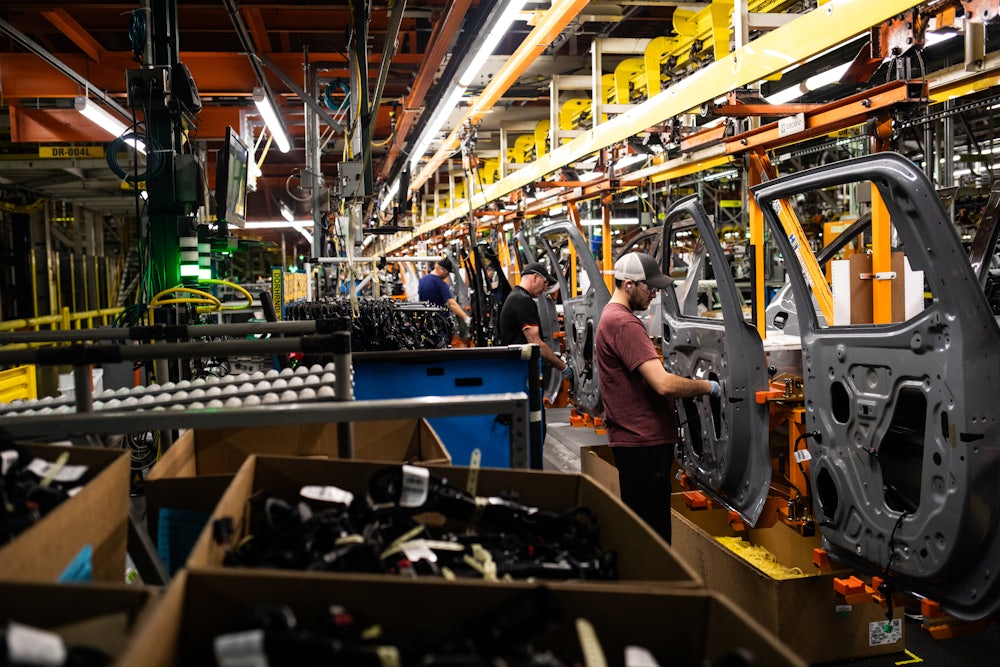Announcing a barrage of new tariffs on the White House lawn yesterday, Donald Trump promised that jobs and factories “will come roaring back into our country.” He paid special attention to the 20 or so autoworkers in the audience. “The autoworkers were fantastic,” he said. “You’re going to be very happy soon.” At one point during the speech, Trump pulled one of his trademark red Make America Great Again hats from the dais. “Come here. Thank you, fellas. Get it. That’s it. That’s it,” he said, offering them the cap.
What else they’ll get from the administration besides that isn’t clear. As markets reel from Wednesday’s tariff announcements, the U.S. auto industry is continuing to figure out its next steps. Roughly 46 percent of vehicles sold here last year were made in other countries. Investment analysts at Bernstein Research estimate that 57 percent of the parts that make up vehicles assembled in the United States are sourced abroad; those items are due to face tariffs by May 3. GM—which imports 48 percent of the vehicles it sells in the U.S., and sources less than 40 percent of its parts domestically—could face a 79 percent drop in earnings before interest and taxes, Bernstein estimates.
Automakers had lobbied to exempt vehicles made in Mexico and Canada that comply with the terms of the U.S.-Mexico-Canada Agreement, or USMCA. The Trump administration is subjecting them to the 25 percent tariff anyway. The value of U.S.-made parts included in those cars will be deducted from the total amount that gets assessed, however. For example: A car made in Mexico that costs $40,000 would be subject to a $10,000 levy if it’s shipped to the U.S. If that car contains $5,000 worth of U.S.-made parts, it’d be charged $8,750—i.e., 25 percent of $35,000.
Trump has argued that auto tariffs will compel companies to bring production back into the U.S. The United Auto Workers—while critical of Trump’s action on other fronts—has enthusiastically endorsed his auto import tariffs on those grounds. “With these tariffs, thousands of good-paying blue collar auto jobs could be brought back to working-class communities across the United States within a matter of months, simply by adding additional shifts or lines in a number of underutilized auto plants,” the union wrote in a statement responding to the auto tariff announcement last week.
The reality may be more complicated, especially given the extent to which U.S. automakers have structured production around the expectation of free trade with Mexico and Canada. “There is some wiggle room for certain products, but that still costs a lot of money and time,” says Stephanie Brinley, associate director of AutoIntelligence at S&P Global Mobility. The easiest places to shift production will be for models that are already produced at plants in Mexico or Canada and the U.S. The Chevrolet Silverado, for instance, is made at two plants in the U.S. and one each in Mexico and Canada. On Thursday, GM announced that it will add as many as 250 jobs to increase production at an Indiana plant that makes the Silverado and GMC Sierra trucks.
Other news has been less promising. Stellantis, which owns Dodge, Jeep, and Chrysler, has announced that it will temporarily lay off 900 employees in the U.S., including workers at two plants that provide parts to factories it’s idling in Mexico and Canada as a result of the tariffs.
“Most automakers are running at a pretty good capacity rate in the U.S., so the opportunity to move things around is small,” Brinley added, emphasizing that most automakers had yet to announce major production decisions. “This notion that you can pick up a piece of machinery and drive it up north is not even close” to reality, she said. “To make a meaningful move is going to take a year, year and a half. And that’s just if you’re talking about duplicating production. If you’re talking about a new plant, that’s three years.”
Where any new domestic production spurred on by these tariffs takes place will depend on factors ranging from local economic incentives to how quickly certain plants are able to be retooled, and how close certain parts—often produced by third parties—should be made to assembly plants. Considering that nonunion car factories now outproduce the Big Three unionized legacy U.S. automakers, much of that work could go to workers who aren’t represented by unions, in right-to-work states like Alabama and Kentucky. As the Trump administration continues its attempts to undermine the National Labor Relations Board, organizing those shops could become much more difficult.
Increasing production at existing plants and building new ones, moreover, represent big corporate commitments. Those generally require a high level of certainty about what policies will be in place over the coming months and years. The Trump administration, by contrast, has announced and rolled back tariffs at a rapid clip, maximizing chaos. Although some automakers, like Ford, have said they’ll lower prices in response to tariffs, manufacturers are likely to pass at least some of the cost of tariffs on to consumers, adding potentially thousands of dollars to the cost of new cars. Autotrader predicts that the cost of new foreign cars currently priced at less than $40,000 could increase by as much as $6,000. Higher prices are likely to lead to lower sales, and the prospect of a recession—heightened by stock market turmoil this week after the “Liberation Day” announcements—could make companies and investors wary of spending billions of dollars responding to tariffs that might not exist in a month or a year. That might also make them less willing to invest in lines of business where they’ve so far struggled to earn profits, including electric vehicles. “Think about a world where we’re spending billions in capital, and then it ends. We can’t be whipsawing the business back and forth,” GM CFO Paul Jacobson told investors in February when discussing the tariff prospect.
An economic downturn in the U.S. may pose unique risks to Ford and GM, which sell the vast majority of their vehicles domestically. During the last financial crisis—when the government bailed out and briefly took ownership stakes in GM and Chrysler, now owned by Stellantis—foreign markets buoyed declining sales in the U.S. Since that time, legacy U.S. automakers have largely stopped selling compacts and sedans and have withdrawn from international markets; in December, GM announced that it was writing down the value of its business in China by more than $5 billion amid mounting losses there to Chinese companies such as BYD. That U.S. automakers’ sales are so heavily concentrated around selling trucks and SUVs in the U.S. could make them less nimble this time around, especially if penny-pinching consumers opt for smaller, cheaper vehicles now made primarily by foreign automakers. As happened during the recession too, automakers are liable to use any pressure on their bottom lines as an excuse to lay off more workers in the name of efficiency, undermining wages and working conditions.
“If North America has a downturn—or if the U.S. has a downturn—they don’t have another market as strong as this one to offset” losses here, Brinkley said. “If that market is struggling, it’ll have a different kind of an impact” than in 2008. There’s no way of knowing what exactly the future holds, either for the U.S. auto sector or the economy as a whole, of course. While some are optimistic that Trump’s tariffs will rebound in autoworkers’ favor, the next few months will almost certainly find the industry wading through uncharted, potentially dangerous waters.








